
|
Now it is very bright as 4.7 mag (May 2, Marco Goiato). Visible with naked eyes. It will approach to Sun down to 0.43 a.u. in May, and brighten up to 3.5 mag. In the Southern Hemisphere, it stays observable in good condition until mid May. In the Northern Hemisphere, it is only visible in extremely low sky in late May. Then it appears in the morning sky at 11 mag in August. And it will be observable in good condition after that while the comet will be fading.
Date(TT) R.A. (2000) Decl. Delta r Elong. m1 Best Time(A, h)
May 2 0 2.97 -15 11.8 0.715 0.761 48 5.1 3:34 (285, -6)
May 9 0 49.77 4 12.9 0.577 0.635 35 3.8 3:25 (265, -1)
|
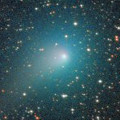
|
Now it is 8.5 mag (Apr. 29, Charles S. Morris). It stays bright as 8-9 mag until July. It is observable in good condition in the Northern Hemisphere. In the Southern Hemisphere, it is not observable until late June.
Date(TT) R.A. (2000) Decl. Delta r Elong. m1 Best Time(A, h)
May 2 6 27.84 76 18.8 1.702 1.616 67 8.1 20:20 (164, 39)
May 9 7 47.41 75 49.2 1.685 1.616 68 8.1 20:28 (164, 42)
|
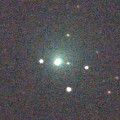
|
Now it is very bright as 9.3 mag (Apr. 25, Chris Wyatt). Brightening very rapidly. It will approach to Sun down to 0.9 a.u. in June, and it is extected to brighten up to 5.5 mag. In the Southern Hemisphere, it stays observable in good condition for a long time after this. In the Northern Hemisphere, it is not observable until late June.
Date(TT) R.A. (2000) Decl. Delta r Elong. m1 Best Time(A, h)
May 2 5 14.54 -22 13.5 1.528 1.238 53 9.3 20:20 ( 70,-10)
May 9 5 33.75 -21 55.7 1.428 1.162 53 8.6 20:28 ( 72,-13)
|
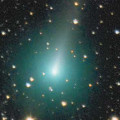
|
Now it is very bright as 8.8 mag (Apr. 28, Carlos Labordena). It continues brightening even after the perihelion passage on Mar. 15. It stays observable for a long time in the Northern Hemisphere. In the Southern Hemisphere, it is not observable until June when it fades down to 13-14 mag. It seems to be a fragment of C/1988 A1 (Liller), like C/1996 Q1 (Tabur) and C/2015 F3 (SWAN).
Date(TT) R.A. (2000) Decl. Delta r Elong. m1 Best Time(A, h)
May 2 5 12.97 82 36.3 1.106 1.199 68 9.6 20:20 (171, 36)
May 9 9 26.25 77 53.5 1.118 1.286 74 10.4 20:28 (171, 46)
|
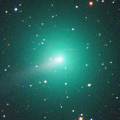
|
Now it is 9.0 mag (Apr. 29, Charles S. Morris). The nucleus was split into some fragments in late March, and the brightness evolution stopped. It brightened up to 7.0 mag in late March ((Mar. 30, Charles S. Morris). However, it is fading now. It moves along the same orbit as C/1844 Y1 (Great Comet). It approaches to Sun down to 0.25 a.u. on May 31. It was expected to brighten up to -1 mag. But it may disappear before the perihelion passage. In the Northern Hemisphere, it stays observable in good condition until mid May. In the Southern Hemisphere, it is not observable until June.
Date(TT) R.A. (2000) Decl. Delta r Elong. m1 Best Time(A, h)
May 2 5 13.79 59 32.8 0.916 0.856 52 9.6 20:20 (144, 31)
May 9 4 46.59 55 29.4 0.868 0.698 42 9.7 20:28 (143, 21)
|
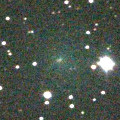
|
Now it is very bright as 10.3 mag (Apr. 25, Chris Wyatt). It will approach to Sun down to 0.3 a.u. on July 3, and it is expected to brighten up to 2.5 mag. In the Southern Hemisphere, it stays observable in good condition until early June when it brightens up to 8 mag. But it will not be observable around the perihelion passage. In the Northern Hemisphere, it is not observable now. It will appear in the evening sky at 3-4 mag in mid July, then it stays observable while getting fainter.
Date(TT) R.A. (2000) Decl. Delta r Elong. m1 Best Time(A, h)
May 2 6 11.00 -22 29.7 1.621 1.496 64 10.3 20:20 ( 62, 0)
May 9 6 8.12 -17 30.7 1.624 1.369 57 9.9 20:28 ( 72, -4)
|
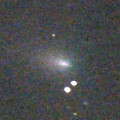
|
Recovered from SWAN images after 24-year blank. Now it is very bright as 10.4 mag (Apr. 28, Chris Wyatt). It stays 10-11 mag until August. In the Southern Hemisphere, it stays observable in the morning sky for a long time. In the Northern Hemisphere, it is too low to observe until July.
Date(TT) R.A. (2000) Decl. Delta r Elong. m1 Best Time(A, h)
May 2 0 18.88 1 54.9 2.084 1.410 36 10.3 3:34 (268, 0)
May 9 0 42.31 3 32.1 2.054 1.395 37 10.2 3:25 (266, 0)
|
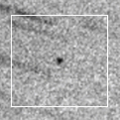
|
It will approach to Sun down to 0.34 a.u. and brighten up to 7 mag in June. In the Southern Hemisphere, it will appear in the evening sky at 7 mag in early July. Then it stays observable in good condition while the comet will be fading. In the Northern Hemisphere, it is not observable until mid August when the comet will fade down to 12 mag.
Date(TT) R.A. (2000) Decl. Delta r Elong. m1 Best Time(A, h)
May 2 2 17.50 19 43.8 2.196 1.200 6 13.5 3:34 (236,-12)
May 9 2 40.12 21 27.4 2.085 1.091 7 12.3 3:25 (234,-11)
|
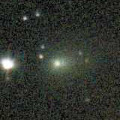
|
Now it is 14.2 mag (Apr. 24, Chris Wyatt). Brightening very rapidly. It will brighten up to 8-9 mag from summer to autumn. It will be observable in excellent condition in the Southern Hemisphere. It locates very low around the high light in the Northern Hemisphere.
Date(TT) R.A. (2000) Decl. Delta r Elong. m1 Best Time(A, h)
May 2 12 55.65 -1 33.4 1.086 2.029 151 13.1 22:12 ( 0, 53)
May 9 12 49.21 -1 17.4 1.080 1.983 143 12.8 21:38 ( 0, 54)
|
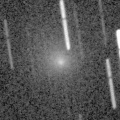
|
Bright new comet. Now it is 13.2 mag (Apr. 28, Alan Hale). It will fade out rapidly after this, and it will be fainter than 18 mag in late June. It stays observable in good condition in the Northern Hemisphere. It will be unobservable after this in the Southern Hemisphere.
Date(TT) R.A. (2000) Decl. Delta r Elong. m1 Best Time(A, h)
May 2 22 43.26 29 18.4 0.694 0.838 55 13.4 3:34 (256, 34)
May 9 23 8.89 52 53.8 0.658 0.861 57 13.4 3:25 (228, 39)
|

|
Now it is 13.3 mag (Apr. 20, Sandor Szabo). It stays bright as 13 mag until June. In the Southern Hemisphere, it will never be observable again.
Date(TT) R.A. (2000) Decl. Delta r Elong. m1 Best Time(A, h)
May 2 1 6.06 62 13.4 4.110 3.541 49 13.7 3:34 (210, 25)
May 9 1 16.32 64 20.6 4.129 3.572 50 13.7 3:25 (208, 27)
|
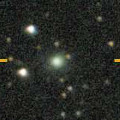
|
Now it is 14.3 mag (Apr. 22, Sandor Szabo). It will brighten up to 10.5 mag from 2020 December to 2021 January. In the Northern Hemisphere, it stays observable in good condition while the comet will be brightening gradually, but it is not observable at the high light. In the Southern Hemisphere, it is not observable for a long time, but it will be observable in good condition after the high light.
Date(TT) R.A. (2000) Decl. Delta r Elong. m1 Best Time(A, h)
May 2 15 34.24 80 12.8 3.067 3.129 84 13.9 0:56 (180, 45)
May 9 14 27.81 79 36.2 3.020 3.064 82 13.8 23:10 (180, 46)
|
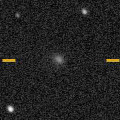
|
Now it is 11.4 mag (Apr. 22, Sandor Szabo). It appeared in the evening sky in the Northern Hemisphere. It will appear in the evening sky at 15 mag in mid May also in the Southern Hemisphere. However, it will fade out rapidly, and will be fainter than 18 mag in June.
Date(TT) R.A. (2000) Decl. Delta r Elong. m1 Best Time(A, h)
May 2 5 22.77 28 35.1 1.091 0.728 40 13.8 20:20 (111, 21)
May 9 6 20.42 30 21.8 1.082 0.825 46 14.7 20:28 (110, 26)
|
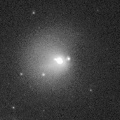
|
Now it is not observable. It will appear in the morning sky in June.
Date(TT) R.A. (2000) Decl. Delta r Elong. m1 Best Time(A, h)
May 2 1 48.64 19 34.5 6.781 5.800 12 13.9 3:34 (240, -7)
May 9 1 54.22 20 7.0 6.760 5.801 16 13.9 3:25 (242, -4)
|
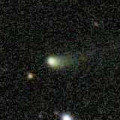
|
Now it is 14.2 mag (Apr. 14, Sandor Szabo). It stays 13-14 mag from 2020 to 2021. It stays observable in good condition for a while.
Date(TT) R.A. (2000) Decl. Delta r Elong. m1 Best Time(A, h)
May 2 12 36.82 17 20.7 2.456 3.255 135 14.2 21:53 ( 0, 72)
May 9 12 33.82 16 56.3 2.502 3.239 129 14.2 21:23 ( 0, 72)
|
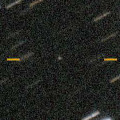
|
Now it is 16.9 mag (Mar. 20, Kunihiro Shima). It will brighten rapidly, and will brighten up to 9.5 mag in June. It is not observable in June. However, it stays observable in good condition until May while the comet is brightening, and after July while the comet will be fading.
Date(TT) R.A. (2000) Decl. Delta r Elong. m1 Best Time(A, h)
May 2 9 19.32 1 50.1 0.526 1.212 99 15.4 20:20 ( 42, 49)
May 9 9 1.67 5 10.5 0.508 1.112 87 14.8 20:28 ( 60, 43)
|
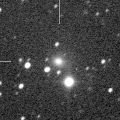
|
Now it is bright as 13.9 mag (Apr. 24, Chris Wyatt). It stays 15 mag until summer. It stays observable for a long time in the Southern Hemisphere. It is not observable until August in the Northern Hemisphere.
Date(TT) R.A. (2000) Decl. Delta r Elong. m1 Best Time(A, h)
May 2 2 36.95 -41 8.7 4.167 3.707 56 14.8 3:34 (295,-47)
May 9 2 43.39 -39 53.7 4.176 3.731 57 14.8 3:25 (294,-45)
|
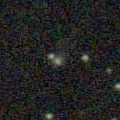
|
Now it is 15.3 mag (Apr. 25, Hiroshi Abe). It will brighten up to 13 mag in 2021. In 2020, it is observable at 15 mag in good condition from spring to summer.
Date(TT) R.A. (2000) Decl. Delta r Elong. m1 Best Time(A, h)
May 2 14 30.06 -20 2.4 4.121 5.126 175 15.2 23:46 ( 0, 35)
May 9 14 24.43 -20 21.1 4.088 5.085 170 15.1 23:13 ( 0, 35)
|
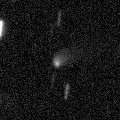
|
Now it is 15.4 mag (Apr. 22, Chris Wyatt). It stays 14-15 mag until 2021. In the Southern Hemisphere, it stays observable in good condition for a long time. In the Northern Hemisphere, it is not observable until June in 2021.
Date(TT) R.A. (2000) Decl. Delta r Elong. m1 Best Time(A, h)
May 2 17 10.81 -82 31.5 4.635 5.086 111 15.4 2:35 ( 0,-28)
May 9 16 59.85 -83 18.0 4.574 5.057 113 15.3 1:57 ( 0,-28)
|
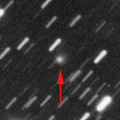
|
Now it is 15.7 mag (Apr. 20, Sandor Szabo). It is expected to be observable at 5-6 mag for a long time from 2022 to 2023. In the Northern Hemisphere, it is not observable at the high light from 2022 summer to 2023 summer. In the Southern Hemisphere, it is only visible in the extremely low sky in summer in 2020. But it will be observable in good condition at the high light.
Date(TT) R.A. (2000) Decl. Delta r Elong. m1 Best Time(A, h)
May 2 18 11.80 52 6.9 9.062 9.259 98 15.5 3:31 (180, 73)
May 9 18 8.60 52 31.5 8.987 9.209 99 15.4 3:01 (180, 72)
|
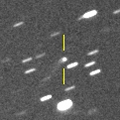
|
Now it is 15.9 mag (Apr. 21, Catalina Sky Survey). It stays 15-16 mag for a long time until 2021.
Date(TT) R.A. (2000) Decl. Delta r Elong. m1 Best Time(A, h)
May 2 20 52.73 3 23.0 4.458 4.491 85 15.8 3:34 (302, 42)
May 9 20 50.53 4 52.3 4.339 4.486 91 15.7 3:25 (305, 46)
|
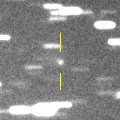
|
First return of a new periodic comet discovered in 2006. It brightened up to 14.9 mag in January (Jan. 21, R. Fichtl). It will never be observable after this.
Date(TT) R.A. (2000) Decl. Delta r Elong. m1 Best Time(A, h)
May 2 3 3.67 5 23.3 2.732 1.758 11 15.9 20:20 (113,-20)
May 9 3 22.92 6 30.7 2.756 1.780 11 16.0 20:28 (116,-23)
|

|
It brightens up to 16 mag in May. But it is not observable in this apparition. It has been observed at three apparitions in 2003, 2012 and 2016.
Date(TT) R.A. (2000) Decl. Delta r Elong. m1 Best Time(A, h)
May 2 2 8.51 11 2.3 1.583 0.603 8 16.0 3:34 (244,-16)
May 9 2 55.07 13 37.7 1.599 0.597 4 15.9 3:25 (237,-19)
|
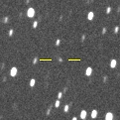
|
Now it is 17.1 mag (Apr. 23, D. Buczynski). It will stay at 14 mag for a long time from 2021 to 2022. In the Northern Hemisphere, it stays observable in good condition while brightening gradually. In the Southern Hemisphere, it stays locating low for a long time.
Date(TT) R.A. (2000) Decl. Delta r Elong. m1 Best Time(A, h)
May 2 19 7.51 33 35.4 6.241 6.480 99 16.1 3:34 (273, 79)
May 9 19 3.81 33 54.8 6.139 6.448 103 16.1 3:25 (277, 83)
|
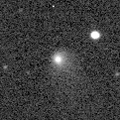
|
It brightened up to 13.8 mag in autumn in 2019 (Sept. 3, Chris Wyatt). Now it is fading slowly. It is appearing in the morning sky in the Southern Hemisphere. It will appear in June also in the Northern Hemisphere. In 2020, it stays observable in good condition while the comet will be fading from 16 to 17 mag.
Date(TT) R.A. (2000) Decl. Delta r Elong. m1 Best Time(A, h)
May 2 0 21.64 -6 7.4 6.210 5.475 39 16.3 3:34 (274, -5)
May 9 0 25.15 -5 20.9 6.175 5.514 45 16.3 3:25 (275, -2)
|

|
It brightened up to 13.2 mag from spring to autumn in 2019 (June 30, Thomas Lehmann). Now it is fading slowly. It has already faded down to 16.0 mag (Apr. 25, iTelescope Observatory, Siding Spring). In the Southern Hemisphere, it stays observable for a long time. In the Northern Hemisphere, it is not observasble until June.
Date(TT) R.A. (2000) Decl. Delta r Elong. m1 Best Time(A, h)
May 2 0 2.42 -32 29.5 4.325 3.929 60 16.3 3:34 (299,-16)
May 9 0 5.53 -31 52.9 4.280 3.965 65 16.3 3:25 (300,-13)
|

|
New comet. Now it is 16.5 mag (May 4, E. Guido, A. Valvasori). It will brighten up to 13.5 mag in spring in 2021. In the Southern Hemisphere, it stays observable in good condition for a long time. In the Northern Hemisphere, it is not observable until spring in 2021.
Date(TT) R.A. (2000) Decl. Delta r Elong. m1 Best Time(A, h)
May 2 22 44.11 -48 28.6 4.602 4.574 82 16.4 3:34 (321,-13)
May 9 22 43.95 -49 33.0 4.452 4.532 88 16.3 3:25 (324,-11)
|
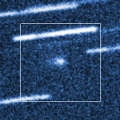
|
New comet. Now it is 15.3 mag (Apr. 25, Ken-ichi Kadota). It approached to Sun down to 0.5 a.u. in March, and it must have brightened up to 14 mag. It will fade out very rapidly after this.
Date(TT) R.A. (2000) Decl. Delta r Elong. m1 Best Time(A, h)
May 2 7 27.90 -2 10.6 0.678 1.047 73 16.4 20:20 ( 64, 28)
May 9 8 21.77 -3 29.7 0.737 1.152 80 17.0 20:28 ( 60, 30)
|
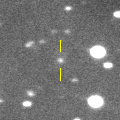
|
Now it is 16.2 mag (Apr. 22, D. Buczynski). It will brighten up to 12 mag in winter in 2022. In the Northern Hemisphere, it stays observable in good condition for a long time. In the Southern Hemisphere, it is not observable until 2021 November.
Date(TT) R.A. (2000) Decl. Delta r Elong. m1 Best Time(A, h)
May 2 23 57.66 47 16.9 7.019 6.359 45 16.5 3:34 (230, 28)
May 9 0 3.83 48 10.0 6.947 6.314 47 16.4 3:25 (230, 30)
|
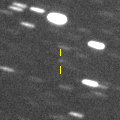
|
Now it is 17.6 mag (Mar. 22, Toshihiko Ikemura, Hirohisa Sato). It will brighten up to 15.5 mag from June to August, and it will be observable in good condition.
Date(TT) R.A. (2000) Decl. Delta r Elong. m1 Best Time(A, h)
May 2 19 6.45 -6 14.9 1.586 2.192 113 16.6 3:34 (341, 47)
May 9 19 12.55 -5 16.6 1.505 2.173 118 16.4 3:25 (345, 49)
|
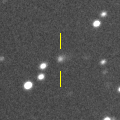
|
Now it is 16.8 mag (Apr. 28, ATLAS-MLO, Mauna Loa). It stays observable at 16-17 mag from 2020 to 2021. It locates somewhat low in the Northern Hemisphere.
Date(TT) R.A. (2000) Decl. Delta r Elong. m1 Best Time(A, h)
May 2 10 41.13 -19 3.5 5.968 6.581 123 16.6 20:20 ( 6, 36)
May 9 10 41.93 -18 25.0 6.048 6.581 117 16.6 20:28 ( 16, 35)
|

|
Now it is 15.8 mag (Apr. 28, ATLAS-MLO, Mauna Loa). It is observable at 16 mag in 2020. It is observable in excellent condition in the Southern Hemisphere. It locates somewhat low in the Northern Hemisphere.
Date(TT) R.A. (2000) Decl. Delta r Elong. m1 Best Time(A, h)
May 2 20 0.89 -29 49.8 6.271 6.610 105 16.6 3:34 (335, 20)
May 9 19 56.88 -29 49.2 6.163 6.621 112 16.6 3:25 (340, 22)
|

|
It brightened up to 7.7 mag in June in 2018 (June 19, Juan Jose Gonzalez). Now it is fading. It has already faded down to 16.9 mag (Apr. 22, J. Drummond). In the Southern Hemisphere, it stays observable for a long time until the comet will fade out. In the Northern Hemisphere, it stays low for a while.
Date(TT) R.A. (2000) Decl. Delta r Elong. m1 Best Time(A, h)
May 2 5 43.88 -13 58.0 7.113 6.581 54 16.6 20:20 ( 73, 0)
May 9 5 46.99 -13 17.4 7.232 6.635 50 16.7 20:28 ( 78, -6)
|
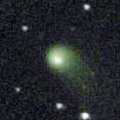
|
It brightened up to 12-13 mag from 2018 to 2019. Now it is fading. It has already faded down to 16.9 mag (Apr. 25, Blue Mountains Observatory, Leura). In the Southern Hemisphere, it stays observable in good condition for a long time. It will never be observable after this in the Northern Hemisphere.
Date(TT) R.A. (2000) Decl. Delta r Elong. m1 Best Time(A, h)
May 2 9 26.76 -69 23.9 4.940 5.349 108 16.8 20:20 ( 9,-16)
May 9 9 20.16 -67 47.4 5.005 5.395 107 16.8 20:28 ( 13,-16)
|
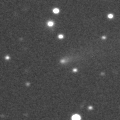
|
Now it is 16.8 mag (Apr. 21, ATLAS-MLO, Mauna Loa). It will be fading after this, and it will be fainter than 18 mag in late June.
Date(TT) R.A. (2000) Decl. Delta r Elong. m1 Best Time(A, h)
May 2 13 3.17 0 45.2 1.286 2.225 151 16.8 22:20 ( 0, 56)
May 9 13 0.97 0 30.9 1.339 2.240 144 16.9 21:50 ( 0, 55)
|
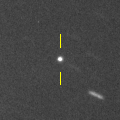
|
It brightened up to 15.9 mag in February and March (Feb. 18, Toshihiko Ikemura, Hirohisa Sato). Now it is fading. It has already faded down to 17.3 mag (Apr. 26, A. Diepvens). It will be fainter than 18 mag in late June.
Date(TT) R.A. (2000) Decl. Delta r Elong. m1 Best Time(A, h)
May 2 10 3.07 5 50.8 1.018 1.648 108 16.9 20:20 ( 28, 57)
May 9 10 7.80 2 21.1 1.080 1.652 104 17.1 20:28 ( 37, 51)
|
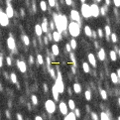
|
Now it is 17.1 mag (Apr. 23, D. Buczynski). It will be observable at 16.5-17 mag from spring in 2020 to summer in 2021.
Date(TT) R.A. (2000) Decl. Delta r Elong. m1 Best Time(A, h)
May 2 19 51.32 23 13.1 4.686 4.864 94 17.1 3:34 (292, 66)
May 9 19 46.31 23 34.4 4.570 4.848 99 17.0 3:25 (300, 70)
|
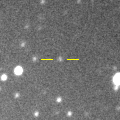
|
Now it is 16.9 mag (Apr. 24, J. Drummond). It is expected to brighten up to 13 mag in 2022. In 2020, it is observable in excellent condition in the Southern Hemisphere. In the Northern Hemisphere, it is not observable. It will be observable from autumn to winter, but it locating extremely low.
Date(TT) R.A. (2000) Decl. Delta r Elong. m1 Best Time(A, h)
May 2 6 24.62 -27 32.1 7.646 7.359 69 17.1 20:20 ( 56, -1)
May 9 6 28.52 -27 3.9 7.662 7.318 66 17.0 20:28 ( 61, -6)
|
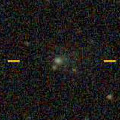
|
Now it is 16.4 mag (Apr. 14, Katsumi Yoshimoto). It will brighten up to 17 mag and will be observable in excellent condition from March to May.
Date(TT) R.A. (2000) Decl. Delta r Elong. m1 Best Time(A, h)
May 2 12 35.46 -1 55.6 1.182 2.101 147 17.1 21:52 ( 0, 53)
May 9 12 35.06 -1 44.5 1.223 2.100 140 17.2 21:25 ( 0, 53)
|

|
Now it is 17.9 mag (Apr. 25, Ken-ichi Kadota). It stays observable at 16-17 mag for a long time until 2024.
Date(TT) R.A. (2000) Decl. Delta r Elong. m1 Best Time(A, h)
May 2 16 9.97 -18 13.7 9.016 9.956 157 17.3 1:31 ( 0, 37)
May 9 16 5.81 -17 56.0 8.958 9.938 165 17.2 0:59 ( 0, 37)
|
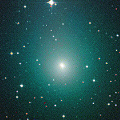
|
It brightened up to 8.3 mag in last September (Sept. 20, Maik Meyer). Now it is fading. It has already faded down to 17.1 mag (Apr. 5, iTelescope Observatory, Siding Spring). In the Southern Hemisphere, it stays observable for a long time after this. In the Northern Hemisphere, it will never be observable again.
Date(TT) R.A. (2000) Decl. Delta r Elong. m1 Best Time(A, h)
May 2 1 3.39 -60 43.0 3.438 3.382 78 17.3 3:34 (324,-36)
May 9 1 18.39 -62 30.9 3.435 3.452 82 17.4 3:25 (326,-36)
|

|
Now it is 17.2 mag (Apr. 24, J. Drummond). It will brighten up to 15.5 mag in early 2021. In 2020, it stays observable at 17 mag until November in the Southern Hemisphere, or until July in the Northern Hemisphere.
Date(TT) R.A. (2000) Decl. Delta r Elong. m1 Best Time(A, h)
May 2 14 38.44 -33 27.2 2.643 3.614 161 17.5 23:55 ( 0, 21)
May 9 14 31.76 -33 16.3 2.585 3.561 162 17.4 23:20 ( 0, 22)
|

|
Now it is 17.6 mag (Apr. 27, ATLAS-MLO, Mauna Loa). It will be fading slowly after this. It is observable in good condition in the Northern Hemisphere. In the Southern Hemisphere, it is observable in the extremely low sky only in 2021 spring.
Date(TT) R.A. (2000) Decl. Delta r Elong. m1 Best Time(A, h)
May 2 12 47.61 54 36.3 8.483 8.818 106 17.4 22:04 (180, 71)
May 9 12 44.58 54 2.5 8.554 8.830 102 17.5 21:34 (180, 71)
|
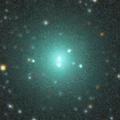
|
It brightened up to 10.2 mag in February (Feb. 6, Maik Meyer). Now it is fading rapidly. It has already faded down to 15.0 mag (Apr. 15, Thomas Lehmann). It is observable in good condition in the Northern Hemisphere. In the Southern Hemisphere, it is only visible in the extremely low sky in spring.
Date(TT) R.A. (2000) Decl. Delta r Elong. m1 Best Time(A, h)
May 2 6 14.19 36 32.2 2.517 2.062 52 17.5 20:20 (114, 33)
May 9 6 22.07 34 38.0 2.703 2.147 47 18.0 20:28 (115, 27)
|
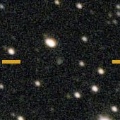
|
Now it is 17.3 mag (Apr. 23, D. Buczynski). It will be observable at 16.5-17 mag from 2020 to 2021.
Date(TT) R.A. (2000) Decl. Delta r Elong. m1 Best Time(A, h)
May 2 1 44.89 66 57.4 6.884 6.319 52 17.6 3:34 (203, 24)
May 9 1 49.15 67 5.7 6.885 6.302 51 17.6 3:25 (204, 25)
|
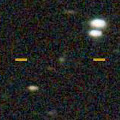
|
Now it is 17.3 mag (Apr. 24, Catalina Sky Survey). It became brighter than orignally predicted. It stays observable at 17 mag in good condition until autumn.
Date(TT) R.A. (2000) Decl. Delta r Elong. m1 Best Time(A, h)
May 2 12 45.00 -6 52.5 1.389 2.324 151 17.7 22:02 ( 0, 48)
May 9 12 41.43 -6 54.2 1.410 2.301 143 17.6 21:31 ( 0, 48)
|

|
Now it is 17.6 mag (Apr. 24, D. Buczynski). It will brighten up to 16.5 mag and will be observable in good condition from June to October.
Date(TT) R.A. (2000) Decl. Delta r Elong. m1 Best Time(A, h)
May 2 20 6.55 2 45.7 2.023 2.362 96 17.8 3:34 (315, 49)
May 9 20 13.58 4 24.0 1.933 2.341 100 17.6 3:25 (317, 52)
|

|
It will pass the perihelion in 2021, and it is predicted to be observable at 17-18 mag from 2020 to 2022. However, it has not been observed at all since 2015. It was not detected, fainter than 20.5 mag, in 2017 May (Werner Hasubick).
Date(TT) R.A. (2000) Decl. Delta r Elong. m1 Best Time(A, h)
May 2 20 37.03 -22 6.4 5.903 6.088 95 17.7 3:34 (324, 24)
May 9 20 38.88 -21 60.0 5.782 6.074 102 17.6 3:25 (327, 26)
|

|
Now it is 17.6 mag (Feb. 3, ATLAS-HKO, Haleakala). It brightened up to 14 mag from autumn to winter in 2018. Now it is fading. It will be fainter than 18 mag in May.
Date(TT) R.A. (2000) Decl. Delta r Elong. m1 Best Time(A, h)
May 2 12 53.77 -3 1.5 3.942 4.853 151 17.7 22:10 ( 0, 52)
May 9 12 49.59 -3 5.7 4.038 4.891 144 17.8 21:39 ( 0, 52)
|
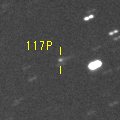
|
Now it is 17.7 mag (Apr. 14, Y. Sugiyama). It will brighten up to 13 mag in 2022. In 2020, it is observable at 17.5 mag in good condition in spring. It locates somewhat low in the Southern Hemisphere.
Date(TT) R.A. (2000) Decl. Delta r Elong. m1 Best Time(A, h)
May 2 10 8.69 21 24.6 4.061 4.424 104 17.7 20:20 ( 44, 72)
May 9 10 9.62 21 3.4 4.151 4.410 98 17.7 20:28 ( 60, 66)
|
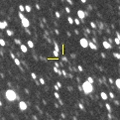
|
Now it is 18.4 mag (Apr. 22, W. Hasubick). It stays observable at 18 mag for a long time from 2019 to 2021.
Date(TT) R.A. (2000) Decl. Delta r Elong. m1 Best Time(A, h)
May 2 19 17.09 -16 17.3 7.231 7.683 113 17.7 3:34 (341, 37)
May 9 19 15.83 -16 44.0 7.127 7.684 120 17.7 3:25 (347, 37)
|
|
![]()
 C/2018 U1 ( Lemmon )
C/2018 U1 ( Lemmon ) C/2017 B3 ( LINEAR )
C/2017 B3 ( LINEAR ) C/2018 A6 ( Gibbs )
C/2018 A6 ( Gibbs ) C/2020 J1 ( SONEAR )
C/2020 J1 ( SONEAR ) P/2020 G1 ( Pimentel )
P/2020 G1 ( Pimentel ) C/2019 L3 ( ATLAS )
C/2019 L3 ( ATLAS ) 115P/Maury
115P/Maury C/2019 C1 ( ATLAS )
C/2019 C1 ( ATLAS ) C/2017 U7 ( PanSTARRS )
C/2017 U7 ( PanSTARRS ) C/2016 M1 ( PanSTARRS )
C/2016 M1 ( PanSTARRS ) C/2017 M4 ( ATLAS )
C/2017 M4 ( ATLAS ) P/2019 Y2 ( Fuls )
P/2019 Y2 ( Fuls ) 124P/Mrkos
124P/Mrkos C/2017 Y2 ( PanSTARRS )
C/2017 Y2 ( PanSTARRS ) C/2019 T4 ( ATLAS )
C/2019 T4 ( ATLAS ) 87P/Bus
87P/Bus C/2020 F2 ( ATLAS )
C/2020 F2 ( ATLAS ) C/2018 W2 ( Africano )
C/2018 W2 ( Africano ) 28P/Neujmin 1
28P/Neujmin 1 C/2010 U3 ( Boattini )
C/2010 U3 ( Boattini ) C/2020 A2 ( Iwamoto )
C/2020 A2 ( Iwamoto ) C/2019 T3 ( ATLAS )
C/2019 T3 ( ATLAS ) 278P/McNaught
278P/McNaught 257P/Catalina
257P/Catalina C/2014 F3 ( Sheppard-Trujillo )
C/2014 F3 ( Sheppard-Trujillo ) (944) Hidalgo
(944) Hidalgo 117P/Helin-Roman-Alu 1
117P/Helin-Roman-Alu 1 C/2017 K5 ( PanSTARRS )
C/2017 K5 ( PanSTARRS )![]()












































